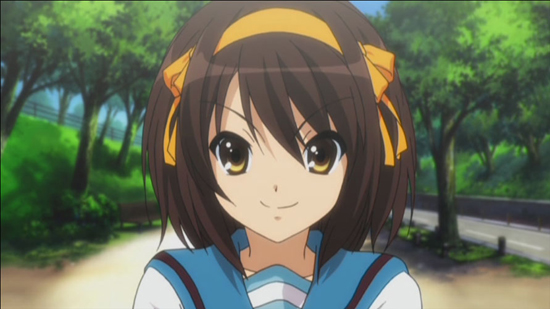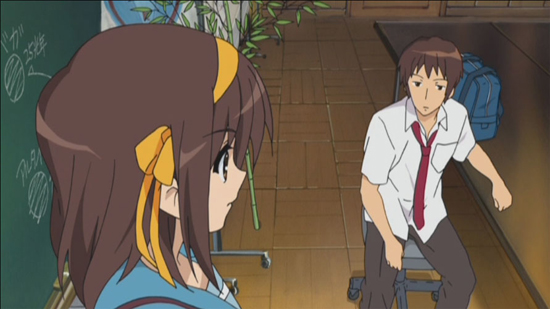
Much like Macross helped define anime of the early ’80s and Evangelion is the poster boy for mid/late 1990s anime, The Melancholy of Haruhi Suzumiya is one of the medium’s touchstones of the present day. The series and its titular villain burst onto the scene in 2006, and controversy swirled around it from the beginning. Was the series responsible for stoking the moe anime craze to new heights, or was it a clever and subversive deconstruction of otaku treasures like light novels and dating sims? Was it really well-animated, or were fans distracted by its comely, always on-model cast? What was with that weird dance the characters did over the closing credits? And what order were we supposed to watch the episodes in, anyway? Whatever conclusions you might draw, The Melancholy of Haruhi Suzumiya was a compelling series, so it’s no surprise that we’re gifted with a sequel a few years down the road.
Once again, this new series—which retains its title, simply appended “Second Season”—takes some odd routes in its approach to storytelling. Whereas the original could be experienced in a couple of different ways depending on whether you chose the on-air sequence or the DVD sequence, this time Haruhi Suzumiya starts with the Groundhog Day approach of presenting the same situation over and over again. Then, it continues with the Groundhog Day approach of presenting the same situation over and over again. I’m not just repeating myself to be funny, either—this sequence of episodes is infamous among fans of the franchise, entitled “Endless Eight” because the same story—a lazy tale of Haruhi and her friends enjoying their summer vacation—plays out eight times, over eight episodes.
There are minor differences. Sometimes the characters’ clothes change, or events happen in a slightly different order, or the dialogue is slightly different. Each change is writ small, so you’ll really have to pay attention to notice them. Towards the end of the sequence, the music cues change subtly, and the atmosphere becomes ominous and claustrophobic as Haruhi’s foil Kyon begins to realize that something is wrong. Turns out that the gang is stuck in a time loop, because Haruhi herself just isn’t ready to let summer vacation end. This, by the way, is the show’s great premise—that bubbly and bossy high-schooler Haruhi Suzumiya is either the supreme being, or a reality-bending psychic at the center of an extremely bizarre and inexplicable natural phenomenon. It’s kind of like that segment of the Twilight Zone movie where that bratty little boy can manipulate reality, only instead of torturing people by removing their mouths and having them devoured by cartoon animals, Haruhi subconsciously creates weird situations for herself and her friends. Keeping her immense ego in check is Kyon, the show’s hero, a polite and quiet young man who drives the story with a sour, sarcastic internal monologue. Mostly, this formula works, but in Endless Eight it slowly falls apart, simply because the sequence of episodes is too long—the amazing and wonderful Urusei Yatsura: Beautiful Dreamer film explores a similar idea much more artfully. That’s not to say that Endless Eight is artless—it’s just a good concept that falls short in execution. Unless you have a lot of time on your hands, only the first and last Endless Eight episodes are necessary viewing to enjoy the series.

I referred to Haruhi herself as the show’s villain in the first paragraph. That was a little uncharitable of me, but it’s really not off-target: Kyon is the protagonist, and Haruhi is the antagonist, the source of much of the show’s conflict and tension. She’s still a pretty neat character—particularly in the first season, she was irresistible; a ball of fire with a festive yellow ribbon in her hair who pined for adventures with ESPers, aliens, and time-travelers and refused to settle for less. She wasn’t one to sit cutely and quietly in the snow, either; instead she formed a weird club and took the gang exploring, started baseball games, and extorted the computer club. Here, Haruhi’s flaws—her immense insensitivity, mainly—cast her as a bully to be reined in. The surrounding cast—quiet and waifish alien Yuki, sweet, buxom, and dumb time-traveler Mikuru, and cagey ESPer Koizumi—are generally too intimidated by Haruhi’s power to rein her in, and don’t wish to blow their cover (because obviously, the adventure-hungry Haruhi is completely oblivious to her companions’ weird backgrounds) so it’s up to Kyon. This makes sense, because naturally, we are supposed to root for Kyon and Haruhi falling for each other, since they are opposites. But frankly, by the end of this series, which cleverly loops right back into the narrative of the first season, I was wondering when Haruhi was going to use the SOS Brigade to launch a sarin gas attack on the Tokyo subways—she was being such a dick to everyone (especially Mikuru) that I kept checking my old Superman comic books to see if she’d suddenly turn up on the cover, telling Lois Lane that she had to marry Gorilla Grodd.
Technically, The Melancholy of Haruhi Suzumiya Second Season leaves little to complain about. The characters still look and sound great (I enjoy both the Japanese and English versions, and have a hard time choosing between the two), though the animation, helmed by Yasuhiro Takemoto instead of the departed Yutaka Yamamoto, is generally less ambitious. I miss the kind of fluid, dynamic animation that characterized the original show’s famous ending-theme dance, the hare hare yukai, though I sure as hell don’t miss the dance itself. Still, the show has some visual luster, and Bandai Entertainment’s packaging of the season as a set instead of individual discs is fair and generous. Particularly generous are the selection of extras—not only does Bandai cram the series discs full of music videos, making-of vignettes, interviews, and their own ASOS Brigade viral videos, they even throw in a CD single featuring full-length versions of the OP and ED songs. As someone who often pines for catchy anime tunes that are never easy to locate on this side of the pacific, I really, really love this feature, and wish more releases sported it. In fact, there’s just one thing about the physical release of this series that gets on my nerves. Take a gander:

On the left, we have the season 1 collection. On the right, there’s Second Season. Notice how they’re the same title, the same font, the same character, in nearly the same pose? When Second Season was released in October, I kept walking past it at shops, thinking it was the first season. It doesn’t look bad, I just think it’s dumb to make a totally separate product look almost identical to something that came out last year. Yeah, I know, it’s a nitpick—what can I say? This is the kind of thing I think about when I’m sitting at home all by myself and the power goes out.
On its face, Second Season is a bit of a mixed bag—the Endless Eight episodes are hard to swallow if you take them all on, and the enjoyment of watching the characters is colored heavily by the discomfort of watching Haruhi basically fall apart over the last story arc. Still, I don’t count myself as one of this show’s biggest fans, but I found Second Season to be worthwhile viewing. It’s crucial as a companion to the fine first season, because it actually cleverly loops right into the original episodes’ narrative. On the downside, this means that there’s yet another order to watch the episodes in. But if you like Haruhi and her pals, this is a no-brainer; if you’re a bit more casual, it’s still ultimately worth squirming through while we all wait for the forthcoming Haruhi Suzumiya movie to be released.

